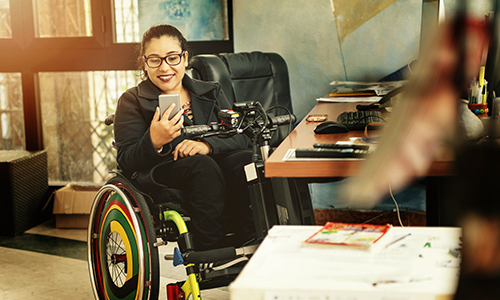When you’re ready to return to work, you’ll need to make some adaptions to your work environment due to your spinal cord injury. Here are a few tips and suggestions to get you started.
Returning to work after a spinal cord injury requires that you and your employer make some workplace accommodations to stay safe, be comfortable, and make it easier for you to get things done. Fortunately, there are many innovations and assistive technology that help you create a great working environment. Most assistive technology products and adaptive equipment cost very little, so it’s in your employer’s best interest to make these relatively minor workspace accommodations.
General office workplace accommodations
If you have an office job, it’s an easily adaptable environment for people with a spinal cord injury. There are several workplace accommodations you should consider for office environments and desk work. Some practical workplace accommodations include
· A layout of your desk and workspace that is roomier to accommodate your wheelchair dimensions and allow you to move around freely without bumping into things
· Assistive technology software (if you have little or no hand function) such as voice dictation
· Other adaptive equipment or assistive technology, such as smart voice-enabled gadgets, ergonomic office supplies, or universal cuffs that attach to most items
· An ergonomically designed keyboard and mouse or trackball, headsets and speakerphones for easy telephone communication, and a raised or adjustable-height desk for optimum positioning
· Commonly used office supplies that make handling paper easier, such as copyholders, vertical files, page-turners, and lazy Susan tabletop holders
Accommodations for wheelchairs in the workplace
Working long hours in a wheelchair can be detrimental to your health. Besides the fatigue you’ll feel, wheelchair sitting for long stretches may cause a loss of circulation, spasticity, pressure sores, and other issues.
Fortunately, an essential workplace accommodation like a powered standing wheelchair can help alleviate the issues caused by extended sitting. When used in combination with a height-adjustable or standing desk, a standing wheelchair allows you to stretch out and minimize stress to your body while continuing to work on a computer, make calls, and do other needed desk work. Also, in a survey with spinal cord-injured individuals, 31 percent reported improved breathing while standing.
The downside is that standing wheelchairs are expensive. Your insurance or employer may not pay for all or some of the cost of a standing wheelchair. If your insurance or employer is unwilling to offer assistance, consult with your occupational therapists on other financing and financial aid options.
Your employer obligations for workplace accommodations
U.S. employers are required by the Americans with Disabilities Act (ADA) to make reasonable workplace accommodations for those with a disability, such as paralysis from a spinal cord injury. Other countries have similar laws.
Regardless of the legal obligations, your employer may be willing to go above and beyond what’s required to help you to work productively. Don’t forget that your employer highly values talent and a strong work ethic. Don’t hesitate to ask for any other workplace accommodations that will help you to continue to be a stellar employee.
References:
- https://www.unitedspinal.org/pdf/Request_Reasonable_Accommodations.pdf
- https://www.dol.gov/odep/topics/accommodations.htm
- https://www.resna.org/Portals/0/Documents/Position%20Papers/RESNAStandingPositionPaper_Dec2013.pdf
- https://hiehelpcenter.org/2017/10/11/standing-wheelchairs-improve-users-health-independence-wont-insurance-agencies-cover/
- https://www.jsonline.com/story/news/politics/2019/07/10/bill-aims-expand-insurance-coverage-would-make-easier-people-wheelchairs-pay-technology-allows-them/1681866001/








